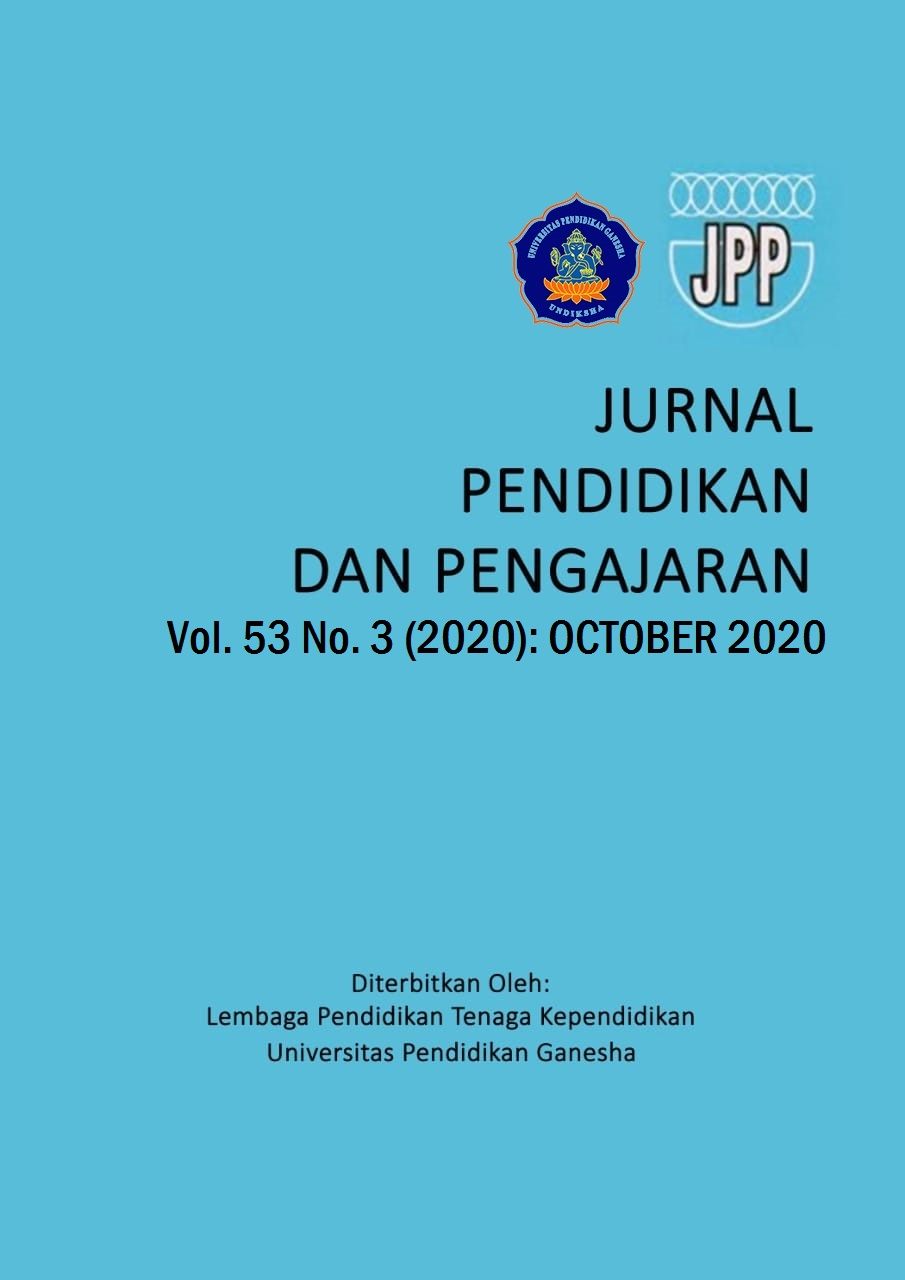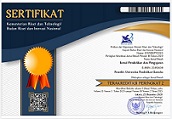The Effectivity of 3D Interactive Multimedia to Increase the Students’ Visuospatial Abilities in Molecular
DOI:
https://doi.org/10.23887/jpp.v53i3.25883Keywords:
research and development, interactive multimedia, molecular shape geometry, effectiveness, visual-spatial intelligenceAbstract
This research and development aims to develop interactive 3D multimedia that appropriate to increase students’ visuospatial abilities at molecular shapes geometry studies. This research and development use the modified research and development 4D Thiagarajan design model that limiting until the development testing step. The descriptive qualitative analysis is used to assess the data result. The multimedia effectiveness is stated based on the increasing right-answered percentage and N-Gain score interpretation. The result shows that it has an increasing right-answered percentage > 50% in each test indicator and signification rate at range 0,5174 – 1,0000 in the medium until high level. The achievement of two kind effectiveness’ criteria can be stated that interactive 3D multimedia is appropriate as the effective learning media to increase student’s visuospatial abilities. Visual model in 2D and 3D utilization can aid the students’ representation skill, so that it can be applied to the other relevant matter.
References
Achuthan, K., Kolil, V. K., & Diwakar, S. (2018). Using Virtual Laboratories in Chemistry Classrooms As Interactive Tools Towards Modifying Alternate Conceptions in Molecular Symmetry. Education and Information Technologies, 23(6), 2499–2515. https://doi.org/10.1007/s10639-018-9727-1
Adytia, P. F., & Dwiningsih, K. (2018). Pengembangan Lembar Kegiatan Siswa Berorientasi Literasi Sains Pada Materi Ikatan Kimia. UNESA Journal of Chemical Education, 7(3), 358–364.
Antonoglou, L. D., Charistos, N. D., & Sigalas, M. P. (2011). Design, Development and Implementation of a Technology Enhanced Hybrid Course on Molecular Symmetry: Students’ Outcomes and Attitudes. Chemistry Education Research and Practice, 12(4), 454–468. https://doi.org/10.1039/C0RP90013C
Asyhar, R. (2012). Kreatif Mengembangkan Media Pembelajaran. Jakarta.
Baloyi, L. L., Ojo, S. O., & Van Wyk, E. A. (2017). Design and Development Of An Interactive Multimedia Simulation For Augmenting The Theacing and Learning Of Programming Concepts. ERIC, 67–93.
Barrett, T. J., Stull, A. T., Hsu, T. M., & Hegarty, M. (2015). Constrained Interactivity for Relating Multiple Representations in Science: When Virtual Is Better Than Real. Computers and Education, 81, 69–81. https://doi.org/10.1016/j.compedu.2014.09.009
Becker, N., Stanford, C., Towns, M., & Cole, R. (2015). Translating Across Macroscopic, Submicroscopic, and Symbolic Levels: The Role of Instructor Facilitation In An Inquiry-Oriented Physical Chemistry Class. Chemistry Education Research and Practice, 16(4), 769–785. https://doi.org/10.1039/c5rp00064e
Carlisle, D., Tyson, J., & Nieswandt, M. (2015). Fostering Spatial Skill Acquisition by General Chemistry Students. Chemistry Education Research and Practice, 16(3), 478–517. https://doi.org/10.1039/c4rp00228h
Chang, R., & Goldsby, K. A. (2014). General Chemistry: The Essential Concepts (Seventh Ed). New York: McGraw-Hill.
Chang, H. Y., & Linn, M. C. (2013). Scaffolding Learning from Molecular Visualizations. Journal of Research in Science Teaching, 50(7), 858–886. https://doi.org/10.1002/tea.21089
Daryanto. (2013). Media Pembelajaran. Yogyakarta: Gava Media.
Fatemah, A., Rasool, S., & Habib, U. (2020). Interactive 3D Visualization of Chemical Structure Diagrams Embedded in Text to Aid Spatial Learning Process of Students. Journal of Chemical Education, 97(4), 992–1000. https://doi.org/10.1021/acs.jchemed.9b00690
Fernandes, R., & Yamanaka, T. (2019). Interactive Design vs. Design for Interaction: Developing Interactive Play Tools that Promote Interactions between Children. In Interactive Multimedia - Multimedia Production and Digital Storytelling. IntechOpen. https://doi.org/10.5772/intechopen.84328
Ghibaudi, E., Cerruti, L., & Villani, G. (2019). Structure, Shape, Topology: Entangled Concepts in Molecular Chemistry. Foundations of Chemistry, 1–29. https://doi.org/10.1007/s10698-019-09333-8
Hake, R. R. (1999). Analyzing Change/Gain Scores. American Educational Research Association, (Division D), 1–4.
Hardhy, J., & Syahri, W. (2014). Pengembangan Media Pembelajaran dengan Lectora Inspire Materi Bentuk Molekul untuk Siswa Kelas X IPA SMAN 10. J. Ind. Soc. Integ. Chem., 2015, 7(2), 18–28.
Ibrahim, M. (2001). Model Pengembangan Perangkat Pembelajaran Menurut Jerold E. Kemp & Thiagarajan. Surabaya: PSMS-PPS UNESA.
Koleżyński, A. (2016). The Concepts of An Atom and Chemical Bond in Physics and Chemistry: The Role of Approximations. Semina Scientiarum, 10(0), 31. https://doi.org/10.15633/ss.1555
M. Al-Balushi, S. (2012). The Effect of Macroscopic and Submicroscopic Pictorial Representations on Pre-Service Science Teachers’ Explanations. International Journal of Academic Research, 4(6), 10–14. https://doi.org/10.7813/2075-4124.2012/4-6/b.2
Merchant, Z., Goetz, E. T., Keeney-Kennicutt, W., Cifuentes, L., Kwok, O., & Davis, T. J. (2013). Exploring 3-D Virtual Reality Technology for Spatial Ability and chemistry Achievement. Journal of Computer Assisted Learning, 29(6), 579–590. https://doi.org/10.1111/jcal.12018
Olimpo, J. T., Kumi, B. C., Wroblewski, R., & Dixon, B. L. (2015). Examining The Relationship Between 2D Diagrammatic Conventions and Students’ Success on Representational Translation Tasks in Organic Chemistry. Chemistry Education Research and Practice, 16(1), 143–153. https://doi.org/10.1039/c4rp00169a
Ryoo, K., Bedell, K., & Swearingen, A. (2018). Promoting Linguistically Diverse Students’ Short-Term and Long-Term Understanding of Chemical Phenomena Using Visualizations. Journal of Science Education and Technology, 27(6), 508–522. https://doi.org/10.1007/s10956-018-9739-z
Sundayana, R. (2014). Statistika penelitian pendidikan. Bandung: Alfa Beta.
Trivic, D. D., & Milanovic, V. D. (2018). The Macroscopic, Submicroscopic and Symbolic Level in Explanations of A Chemical Reaction Provided by Thirteen-Year Olds. Journal of the Serbian Chemical Society, 83(10), 1177–1192. https://doi.org/10.2298/JSC171220055T
Tuvi-Arad, I., & Blonder, R. (2010). Continuous Symmetry and Chemistry Teachers: Learning Advanced Chemistry Content Through Novel Visualization Tools. Chemistry Education Research and Practice, 11(1), 48–58. https://doi.org/10.1039/c001046b
Uyulgan, M. A., Akkuzu, N., & Alpat, Ş. (2014). Assessing The Students’ Understanding Related To Molecular Geometry Using A Two-Tier Diagnostic Test. Journal of Baltic Science Education, 13(6), 839–855.
Wu, H.-K., & Shah, P. (2014). Exploring Visuospatial Thinking in Chemistry Learning. Science Education, 88(3), 465–492. https://doi.org/10.1002/sce.10126
Downloads
Published
How to Cite
Issue
Section
License
Authors who publish with Jurnal Pendidikan dan Pengajaran agree to the following terms:- Authors retain copyright and grant the journal the right of first publication with the work simultaneously licensed under a Creative Commons Attribution License (CC BY-SA 4.0) that allows others to share the work with an acknowledgment of the work's authorship and initial publication in this journal
- Authors are able to enter into separate, additional contractual arrangements for the non-exclusive distribution of the journal's published version of the work (e.g., post it to an institutional repository or publish it in a book), with an acknowledgment of its initial publication in this journal.
- Authors are permitted and encouraged to post their work online (e.g., in institutional repositories or on their website) prior to and during the submission process, as it can lead to productive exchanges, as well as earlier and greater citation of published work. (See The Effect of Open Access)





